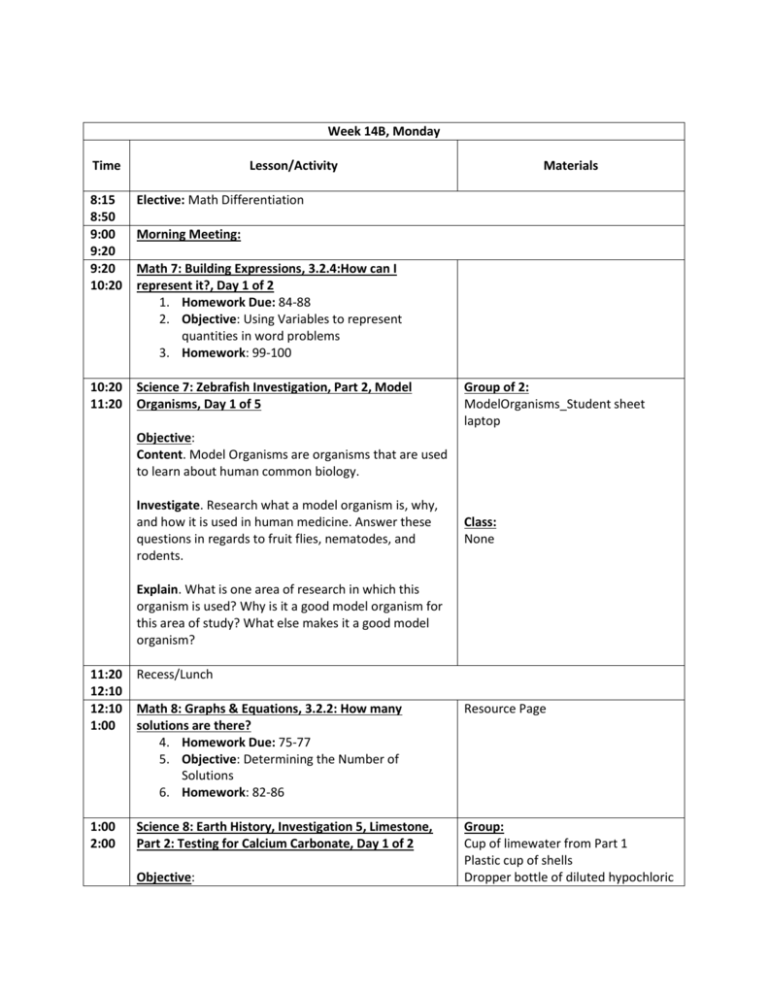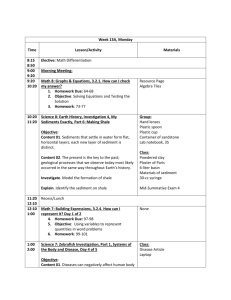Week 14B, Monday Time Lesson/Activity Materials 8:15 8:50
advertisement

Week 14B, Monday Time Lesson/Activity 8:15 8:50 9:00 9:20 9:20 10:20 Elective: Math Differentiation 10:20 11:20 Science 7: Zebrafish Investigation, Part 2, Model Organisms, Day 1 of 5 Materials Morning Meeting: Math 7: Building Expressions, 3.2.4:How can I represent it?, Day 1 of 2 1. Homework Due: 84-88 2. Objective: Using Variables to represent quantities in word problems 3. Homework: 99-100 Group of 2: ModelOrganisms_Student sheet laptop Objective: Content. Model Organisms are organisms that are used to learn about human common biology. Investigate. Research what a model organism is, why, and how it is used in human medicine. Answer these questions in regards to fruit flies, nematodes, and rodents. Class: None Explain. What is one area of research in which this organism is used? Why is it a good model organism for this area of study? What else makes it a good model organism? 11:20 12:10 12:10 1:00 Recess/Lunch Math 8: Graphs & Equations, 3.2.2: How many solutions are there? 4. Homework Due: 75-77 5. Objective: Determining the Number of Solutions 6. Homework: 82-86 Resource Page 1:00 2:00 Science 8: Earth History, Investigation 5, Limestone, Part 2: Testing for Calcium Carbonate, Day 1 of 2 Group: Cup of limewater from Part 1 Plastic cup of shells Dropper bottle of diluted hypochloric Objective: Content 01. Limestone is formed by physical and biological processes. Content 02. Two main sources contribute to the calcium carbonate in limestone: the remains of marine organisms and precipitate formed when carbon dioxide is exhaled by marine organisms into water containing calcium. Investigate. Test various objects, found in the sea, that may contain calcium carbonate. Explain. Explain why limestone fizzes. 2:00 2:50 2:50 3:05 Advisory Caregiver Pick-up acid Lab notebook, seawater investigations, Part 1 Class: Oyster shells Safety goggles Tuesday Time Lesson/Activity Materials 8:15 9:00 9:00 9:20 9:20 10:20 Elective: Math Differentiation Math 7: Building Expressions, 3.2.4: How can I represent it?, Day 2 of 2 7. Homework Due: 99-100 8. Objective: Using Variables to represent quantities in word problems 9. Homework: 101-103 None 10:20 11:20 Science 7: Zebrafish Investigation, Part 2, Model Organisms, Day 2 of 5 Group of 2: ModelOrganisms_Student sheet laptop Prezi Morning Meeting Objective: Content. Model Organisms are organisms that are used to learn about human common biology. Investigate. Choose one, of three, organisms researched as a model organism and create a Prezi presentation. Class: None Explain. Present the information collected on a specific model organism on Prezi. 11:20 12:10 12:10 1:00 Recess/Lunch Math 8: Graphs & Equations, 3.2.3: How can I use my Equation-solving skills? 10. Homework Due: 82-86 11. Objective: Solving Equations to Solve Problems 12. Homework: 92-96 None 1:00 2:00 Science 8: Earth History, Investigation 5, Limestone, Part 2: Testing for Calcium Carbonate, Day 2 of 2 Class: Resource Book, 68-71/Questions, 72 Objective: Content 01. Limestone is formed by physical and biological processes. Content 02. Two main sources contribute to the calcium carbonate in limestone: the remains of marine organisms and precipitate formed when carbon dioxide is exhaled by marine organisms into water containing calcium. Investigate. Read “Where in the world is calcium carbonate” Explain. Answer questions based off the reading. 2:00 2:50 2:50 3:05 Special Caregiver Pick-up Wednesday Time Lesson/Activity Materials 8:15 9:00 9:00 9:20 9:20 10:20 Elective: Math Differentiation Math 7: Building Expressions, 3.2.5: How can I solve it? 1. Homework Due: 101-103 2. Objective: More Word Problem Solving 3. Homework: 105-108 None 10:20 11:20 Science 7: Zebrafish Investigation, Part 2, Model Organisms, Day 3 of 5 Group of 2: ModelOrganisms_Student sheet laptop Prezi Morning Meeting Objective: Content. Model Organisms are organisms that are used to learn about human common biology. Investigate. Choose one, of three, organisms researched as a model organism and create a Prezi presentation. Class: None Explain. Present the information collected on a specific model organism on Prezi. 11:20 12:10 12:10 1:00 Recess/Lunch Math 8: Graphs & Equations, 3.2.4: How can I use my equation-solving skills 4. Homework Due: 92-96 5. Objective: More Solving equations to solve problems 6. Homework: 100-104 None 1:00 2:00 Science 8: Earth History, Investigation 5, Limestone, Part 3: Creating a Limestone Layer Group: Plastic cup Plastic spoon Basin sed layers cup from previous investigations Diluted hydrochloric acid Lab notebook, 39, 41 Objective: Content 01. Limestone is formed by physical and biological processes. Content 02. Two main sources contribute to the calcium carbonate in limestone: the remains of marine organisms and precipitate formed when carbon dioxide is exhaled by marine organisms into water containing Class: Oyster shells Powdered clay calcium. Investigate. Model the formation of limestone layers in an ancient environment Explain. What are the ingredients required to form limestone. 2:00 2:50 2:50 3:05 Special Caregiver Pick-up 30-cc syringe Plaster of Paris Sand Water Safety goggles Thursday Time Lesson/Activity 8:15 9:00 9:00 9:20 9:20 10:20 Elective: Math Differentiation 10:20 11:20 Science 7: Zebrafish Investigation, Part 2, Model Organisms, Day 4 of 5 Materials Morning Meeting Math 7: Building Expressions, Chapter Closure 7. Homework Due: 105-108 8. Objective: Review chapter 3 9. Homework: None Group: laptops Objective: Content. Model Organisms are organisms that are used to learn about human common biology. Explain. Present information on a single model organism to classmates. Class: Mini-iPads Investigate: Use an iPad to take a picture, add text to it, using Skitch, and send the image to Mr. Schrandt using Google Drive. 11:20 12:10 12:10 1:00 Recess/Lunch Math 8: Graphs & Equations, Chapter Closure 1. Homework Due: 100-104 2. Objective: Chapter 3 Review 3. Homework: None None 1:00 2:00 Science 8: Earth History, Investigation 5, Limestone, Part 4: Reading Grand Canyon Rocks, Day 1 of 2 Group: Rock sets Hand lenses Resource Books, 18 Lab Notebook, 42-43 Objective: Content 01. Prehistoric environments can be inferred from evidence from rocks and fossils. Content 02. Change in environments can be inferred through the interpretation of a sequence of sedimentary rock layers. Investigate. Interpret evidence of ancient environments Class: Mid-summative exam 5 Explain. Identify the environments of sedimentary layers. 2:00 2:50 2:50 3:05 Special Caregiver Pick-up Friday Time Lesson/Activity Materials 8:15 9:00 9:00 9:20 9:20 10:20 Elective: Math Differentiation Math 7: Building Expressions, Chapter Test 1. Homework Due: None 2. Objective: Chapter 3 Test 3. Homework: None Chapter 3 Test 10:20 11:20 Science 7: Zebrafish Investigation, Part 2, Model Organisms, Day 5 of 5 Group: Laptops with the following apps: Skitch, camera, and Google Drive Morning Meeting Objective: Content 01. Model Organisms are organisms that are used to learn about human common biology. Content 02. Zebrafish are model organisms because 70% of their genes are found in humans. Class: Mini-iPads 4 Stations Content 03. Wild zebrafish are found in India. They have horizontal stripes, and based off of physical characteristics are either male or female. They are carnivorous. Content 04. Zebrafish are ideal as model organisms because, during embryonic development, the embryos are transparent. Content 05. Zebrafish have the following anatomical parts: Eye, mouth, gills, head, fin, tail Investigate: Visit zebrafish stations to answer the following questions: a. Why are zebrafish used as model organisms? b. What is unique about their embryonic development? c. Observing a specific stage in zebrafish embryonic development, count the number of cells at the current stage. d. The anatomical parts of the zebrafish. Explain. Take a photo, with labels, of the following: a. Adult zebrafish, label the parts b. Embryonic zebrafish, label the parts c. Early cell division of an embryonic zebrafish, label the number of cells and which stage of development. d. Adult zebrafish, measure the length, count the number of stripes, and determine if the observed zebrafish is a male or female. 11:20 12:10 12:10 1:00 Recess/Lunch Math 8: Graphs & Equations, Chapter 3 Test 1. Homework Due: None 2. Objective: Chapter 3 Test 3. Homework: None None 1:00 2:00 Science 8: Earth History, Investigation 5, Limestone, Part 4: Reading Grand Canyon Rocks, Day 2 of 2 Group: Rock sets Hand lenses Resource Books, 18 Lab Notebook, 42-43 Objective: Content 01. Prehistoric environments can be inferred from evidence from rocks and fossils. Content 02. Change in environments can be inferred through the interpretation of a sequence of sedimentary rock layers. Investigate. Interpret evidence of ancient environments Explain. Identify the environments of sedimentary layers. 2:00 2:50 2:50 3:05 Special Caregiver Pick-up Class: Mid-summative exam 5








